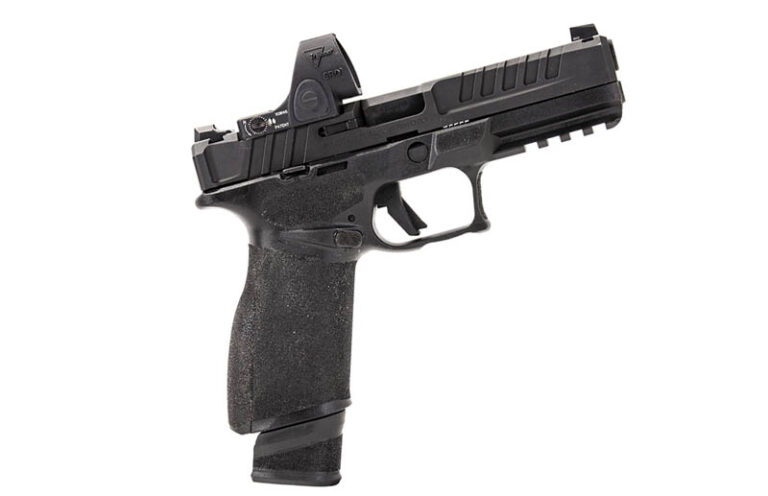
The new Springfield Echelon duty pistol may seem unassuming on the surface, but it has some interesting tricks up its sleeve.
You’re probably looking at this and thinking, “Man, what the gun world really needs right now is a 9mm, polymer-framed, striker-fired handgun.” Because no one is making those, right? Normally, we’d tend to agree with you, but because this pistol was developed with help from one of the greatest shooters the world has seen, we’re not that jaded. Yet.
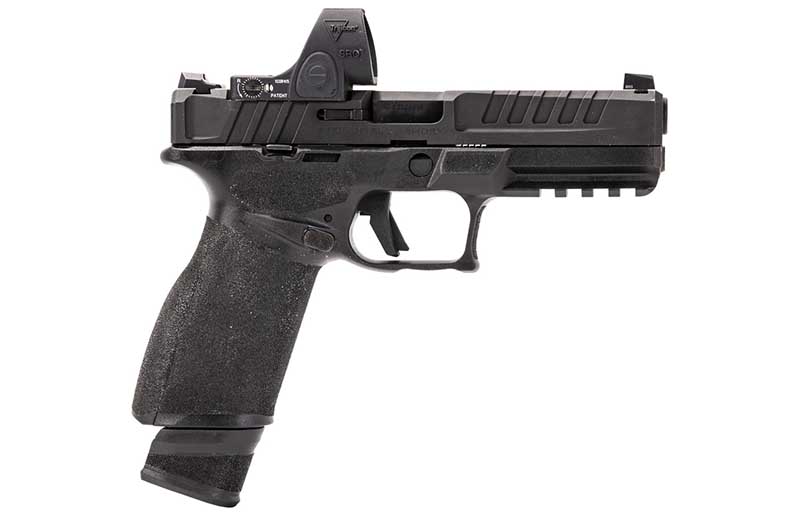
We first clapped eyes on Springfield’s newest offering about two years ago at a range in Croatia. Back then, it didn’t have a name, but representatives from the company had great hopes for it, as did their local partners at HS Produkt.
Springfield’s existing polymer handgun line, built around the venerable XD, was looking a bit long in the tooth, and it was way past time for a refresh. One of the people directing the project was Springfield’s pro staffer, competitor, trainer, and all-round good guy, Rob Leatham. And when you have a multiple-time world champion driving the train, little details tend to get noticed.
Nuts & Bolts Of The Springfield Echelon
Think of a generic striker-fired handgun, and now think of any progress in design that’s been made in its development over the past 40 years. Let’s take grip texturing, for example.
When the Gen 1 Glock 17 came out, it had a lightly textured grip surface, which when placed in wet or bloody hands, was about as secure as a bar of soap.
This led to the next generation of perfection, which confined the same texturing to side panels, while adding deep checkering to the front and backstraps. The third gen added finger grooves, which hindered as many people as they helped.

Gen 4 gave us a uniformly rougher texture all over the grip but kept the finger grooves. And finally, in the fifth iteration, Glock listened to their customers, got rid of the finger grooves, and came out with a Goldilocks texture.
Springfield has vaulted right past all of that bullsh*t and endowed the Echelon with a fine, uniform texture applied to all contact surfaces, which provides plenty of traction, but won’t tear up your shirt or skin when carried IWB.
And while figuring out where to place your hand might be more difficult as a result, Springfield decided in this case to forgo the grip zone.
Now think of every other aspect of pistol design, how it could be improved on any given model, and you’ll probably find it here.
Like the SIG P320, the Echelon is a chassis gun. This provides numerous benefits to the user, including the ability to swap out grip modules should it become damaged and, usually, a more consistent trigger pull.
Unlike SIG, Springfield chose to equip the Echelon frame with replaceable backstraps in order to tailor the gun to the shooter, but there’s also an option to replace the entire frame. The medium-sized backstrap will probably accommodate 80 percent of users, but it’s good to have alternatives if you fall outside this percentile.
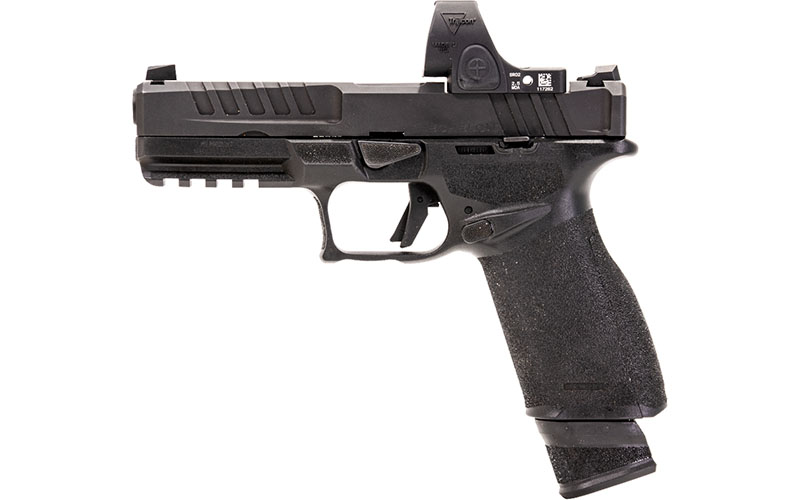
Aftermarket frame surgeons will go hungry if they base their business around the Echelon, as it already has a double undercut trigger guard and stippling every place you can think of, including the magazine basepads. Hell, the factory even textured the end of the recoil spring guide rod, but what function that might perform is anybody’s guess.
Lefties will rejoice, as the pistol is fully ambi, including the magazine catch. That’s right, there’s no need to swap the button from left side to right, as there’s already one in place, well shielded from accidental operation but still easily accessible.
The slide release looks kind of small, but we had no problem either finding it during an emergency reload or using it to lock the slide open for administrative handling. It, too, is shielded with a small fence molded into the grip. The other vital control, the one which makes loud noises, has a conventional blade safety in its face, which when depressed sits perfectly flush with the trigger’s surface.
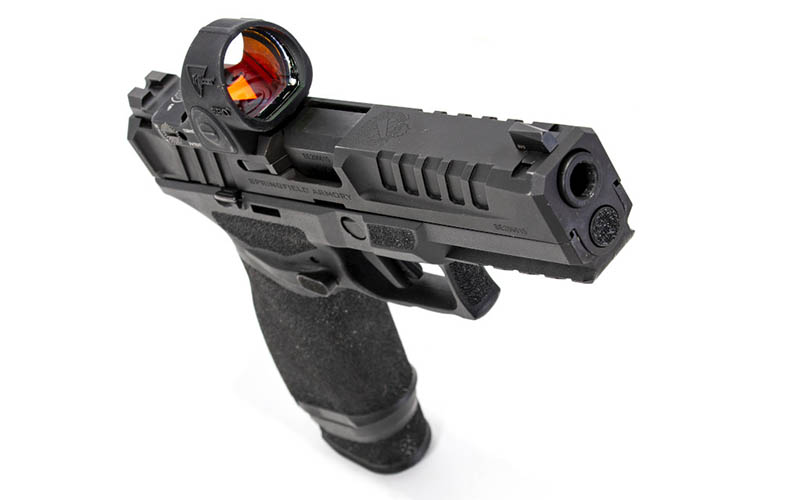
Pull weight on our sample came in at 5.5 pounds, and there’s about a ¼ inch of take-up before reaching the wall, followed by a 16th of an inch rolling break and almost zero overtravel. Is it as good as a Walther or Canik? No, but it probably wouldn’t be too hard to bring it up to speed, and for a handgun aimed squarely at the LE market, it’s a good, duty-style bang switch.
Due to advances in manufacturing, particularly stamping, HS Produkt is able to hold much tighter clearances than before, which translates into a very solid-feeling pistol with almost no play between slide and guide rails.
Anyone who’s dry-fired a 320 with an MRDS is familiar with “dot jump” as the sear slips off the striker — don’t worry, it’s harmless and disappears with a loaded mag, but it’s due to slop caused by guide rails that aren’t bent at a 90-degree angle. In the Echelon, this phenomenon is almost completely absent.
Like a lot of modern striker-fired handguns, the Echelon makes extensive use of metal injection molding (MIM) in its small parts. Curmudgeon traditionalists will no doubt shudder and reminisce longingly over the days when billet-machined components were the norm, but a) forget it, those days aren’t coming back, and b) MIM is an excellent way to make stuff, so long as the part is designed with the process in mind.
When we visited their factory, HS Produkt’s engineers proudly showed off their new Hot Isostatic Pressing machine, which decreases the porosity of MIM parts and greatly increases their strength. It does so by placing the components inside a large pressure vessel filled with argon gas, which is then heated, and the internal pressure increased to up to 30,000 psi.
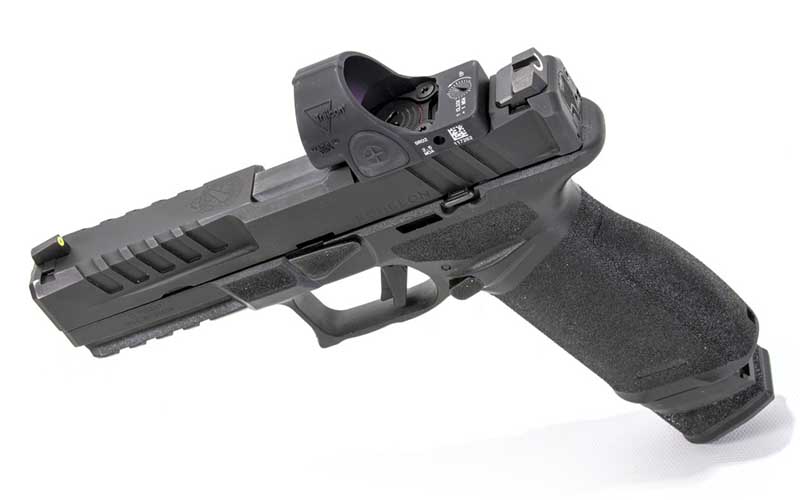
If that sounds like a good way to level a small town in the event of something going wrong, you’d be correct (and one of the engineers joked to us that it was the reason he had a 20-minute commute).
One component definitely not MIM’d is the barrel, which is hammer forged in-house. While some might bag on the Springfield XD series for their grip safety (and let’s get in another dig at the grip zone, while we’re at it), no one complains about accuracy. We have a 5.25-inch barreled XDm in the collection, which is one of the most accurate handguns we’ve ever shot, and used it to place in Production class at the Bianchi Cup.
The Echelon’s barrels come from the same place, and given Leatham’s fanaticism, we expect run-of-the-mill guns coming off the line to have the same kind of potential. Certainly, our preproduction sample left nothing to be desired, turning in 1.2-inch groups at 25 yards with its preferred ammo. That was Norma’s 108-grain MHP, in case you were wondering.
These days, it’d be notable if a handgun’s slide wasn’t cut for optics (looking at you, Dan Wesson), and the Echelon doesn’t disappoint. If you look at the underside, there’s an aha! moment when you realize the striker safety plunger has been moved from the usual position so that there’s no chance it can interfere with optics mounting screw locations, and the optics cut can be made as low as possible.
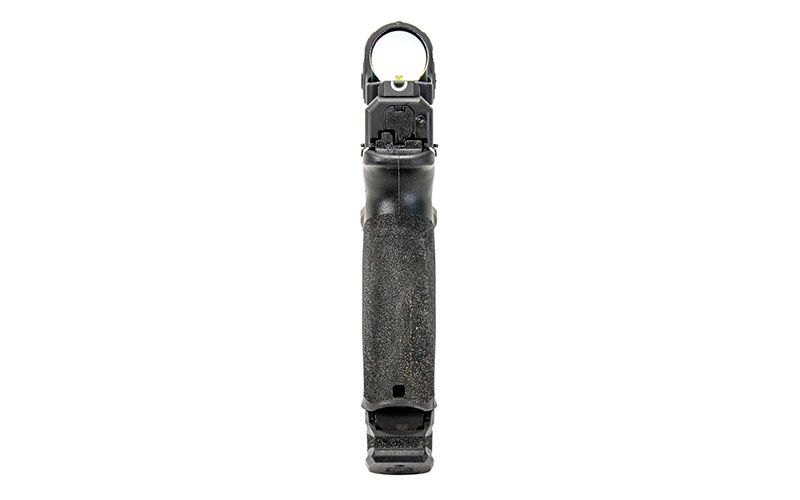
With an RMR bolted up, the red dot’s body sits low enough that standard-height iron sights will cowitness easily, but the slightly thicker SRO means only the top of the front sight is visible through the glass but is still usable in an emergency. For anyone who doesn’t want to avail themselves of the wonders of technology, a cover plate takes care of the unsightly hole, the front sight is bright, green, and tritium-illuminated, while the rear sight is a wide, white-lined U-notch.
Aggressive front and rear cocking serrations adorn the slide’s surface and also serve to reduce reciprocating mass. At the rear is a tapered notch that provides an additional nonslip contact point for anyone slingshotting the slide into battery.
If you’re an XD owner looking to upgrade with another Springfield, then we have a bit of bad news for you: The mags you collected along the way don’t work in the new gun. While they look almost identical, the mag catch slot sits a little higher in Echelon magazines, which makes us believe someone will proudly show off their Dremel skills on Reddit the day after getting their paws on the new gun.
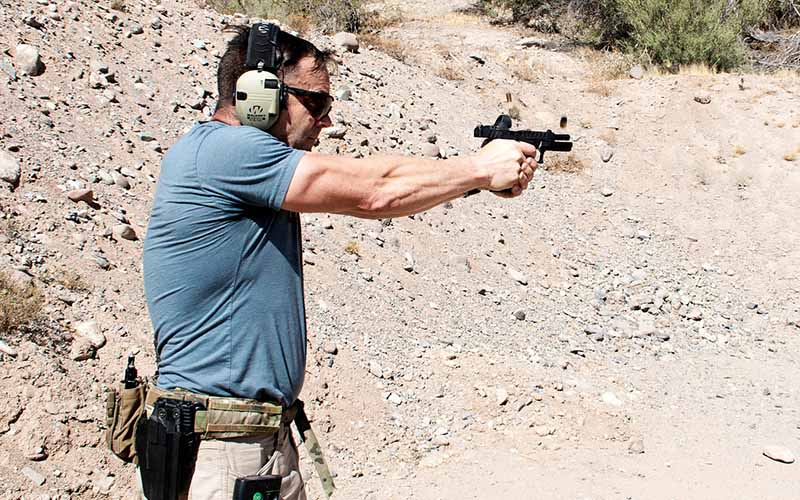
Rounds Downrange
What can we say? It works. When you combine every proven design feature that’s surfaced in duty guns over the past four decades, it’s safe to assume the resulting mix will be pretty damn good. And so it is with the Echelon.
We wish we could find something about it that really grinds our gears, but other than the trigger being about a pound heavier than we’d like in a duty gun, there really isn’t anything negative to say about it. Recoil management is excellent, thanks to its grip shape and texture, and it shoots like a laser beam due to the tight lockup between barrel and slide, aided by minimal slide to frame fit.
Optics users will rejoice at the slide interface, which makes suppressor-height sights utterly redundant and fits the widest range of MRDS options. After a long wait, Springfield has a serious contender in the crowded duty gun market and will no doubt sell a metric asston of them. Or at least they would, if only there were some way to figure out where to place your hand…
Springfield Armory / HS Produkt Echelon
- Caliber: 9mm Luger
- Capacity: 17 rounds
- Barrel Length: 4.5 inches
- Overall length: 7.5 inches
- Weight: 23 ounces
- MSRP: $670
- URL: springfield-armory.com
More Handgun Reviews:
- Beretta 80X Cheetah: Good Kitty Or Damn Pity?
- The Bull’s Eye: Taurus 856 Defender T.O.R.O. Review
- The Big Snake Is Back: 2021 Colt Anaconda Review
- Completely Customizable: Sig P320 Review
- Turkish Take On The Czech Classic: SAR 2000 Review
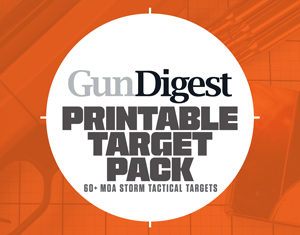
Next Step: Get your FREE Printable Target Pack
Enhance your shooting precision with our 62 MOA Targets, perfect for rifles and handguns. Crafted in collaboration with Storm Tactical for accuracy and versatility.
Subscribe to the Gun Digest email newsletter and get your downloadable target pack sent straight to your inbox. Stay updated with the latest firearms info in the industry.

![Best Concealed Carry Guns In 2025 [Field Tested] Wilson Combat EDC X9S 1](https://gundigest.com/wp-content/uploads/Wilson-Combat-EDC-X9S-1-324x160.jpg)


![Best 9mm Carbine: Affordable PCCs [Tested] Ruger Carbine Shooting](https://gundigest.com/wp-content/uploads/Ruger-Carbine-Shooting-100x70.jpg)
![Best AR-15: Top Options Available Today [Field Tested] Harrington and Richardson PSA XM177E2 feature](https://gundigest.com/wp-content/uploads/Harrington-and-Richardson-PSA-XM177E2-feature-100x70.jpg)
